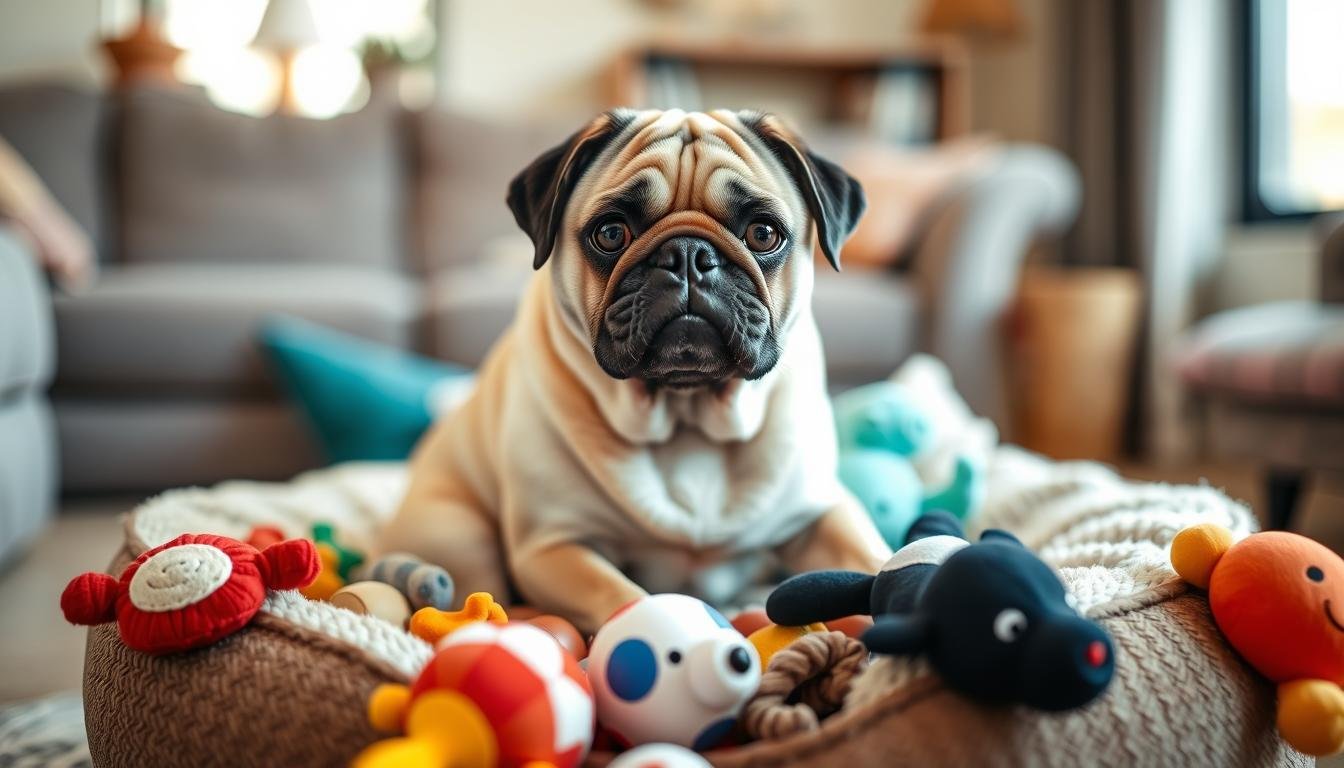How to avoid resource guarding in Pugs
Did you know that 55% of dogs show resource guarding? This includes growling, lunging, and biting to protect their things. If you own a Pug, you might have seen this behavior. But, you can stop and manage it with the right training.
This guide will teach you to spot resource guarding triggers and signs. You’ll also learn how to build your Pug’s confidence and trust. With these skills, you can make your home safe and happy for your Pug. This way, your Pug’s instincts won’t ruin your bond.
Resource guarding in Pugs is common but treatable. With patience and the right methods, you can stop this behavior. You’ll have a happy, well-adjusted Pug that feels safe and confident at home. Let’s explore how to avoid resource guarding in your Pug.
Understanding Resource Guarding in Dogs
Resource guarding is when a dog protects their valuable things from threats. This can show in many ways, from slight body language to full aggression. Knowing what triggers this behavior in Pugs is key to fixing it.
What Is Resource Guarding?
Resource guarding happens when a dog wants to keep something they value, like food or toys. It’s a natural instinct to protect what’s theirs from others. But, it’s a problem if a dog will bite to keep something.
Common Items That Trigger Resource Guarding in Dogs
- Food, including kibble, wet food, and treats
- Chew toys and bones
- Prized possessions, like squeaky toys or stolen “contraband” items
- The dog’s own space, such as their bed or crate
- Their owner or other family members
Knowing what makes your Pug guard their resources is important. By spotting what causes them to be possessive, you can stop and lessen these behaviors.
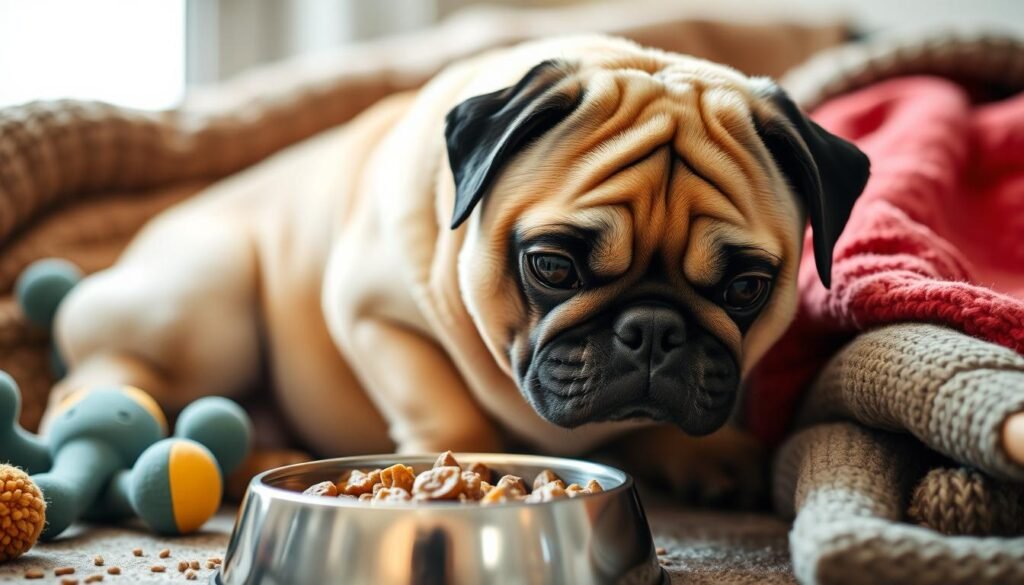
“Resource guarding is a common behavior in dogs, but it can be managed through positive reinforcement training and the establishment of clear boundaries.”
Signs of Resource Guarding in Pugs
Pugs, like all dogs, can show signs of resource guarding. It’s important for owners to spot these signs early. Signs include growling, lunging, and even biting.
But there are also subtle signs. These can be freezing, eating fast, or moving away with something. Knowing these body language cues helps you see if your Pug is guarding resources.
Pugs with a history of neglect might guard more. Adopting a Pug with an unknown past can also lead to guarding. Training and positive reinforcement can help prevent this.
“Understanding the signs of resource guarding in Pugs is the first step in addressing this behavior. Early intervention is key to prevent escalation and maintain a healthy, trusting relationship with your canine companion.”
By recognizing these signs, you can manage your Pug’s behavior. Getting help from a vet or trainer can also be very helpful.
Every Pug is different, and their guarding can show in many ways. Being patient and consistent is key. With a positive approach, your Pug can learn to trust and bond with you and others.
Causes of Resource Guarding Behavior
Resource guarding in dogs, including Pugs, comes from many factors. Knowing what causes it is key to fixing and stopping it.
Genetics and Breed Predispositions
Some dog breeds, like Pugs, might be more likely to guard resources. This is because of how they were bred. Pugs often guard more than other breeds.
History of Resource Scarcity
A Pug’s past can also lead to guarding. If they lived where resources were rare, they might guard what they have more. This is because they learned to protect what little they had.
Stress and Environmental Factors
Stress and changes can make a Pug more likely to guard. A new pet or family member can make them feel insecure. This makes them want to protect their things more.
Knowing why Pugs guard resources helps owners stop it. This keeps everyone safe and happy.
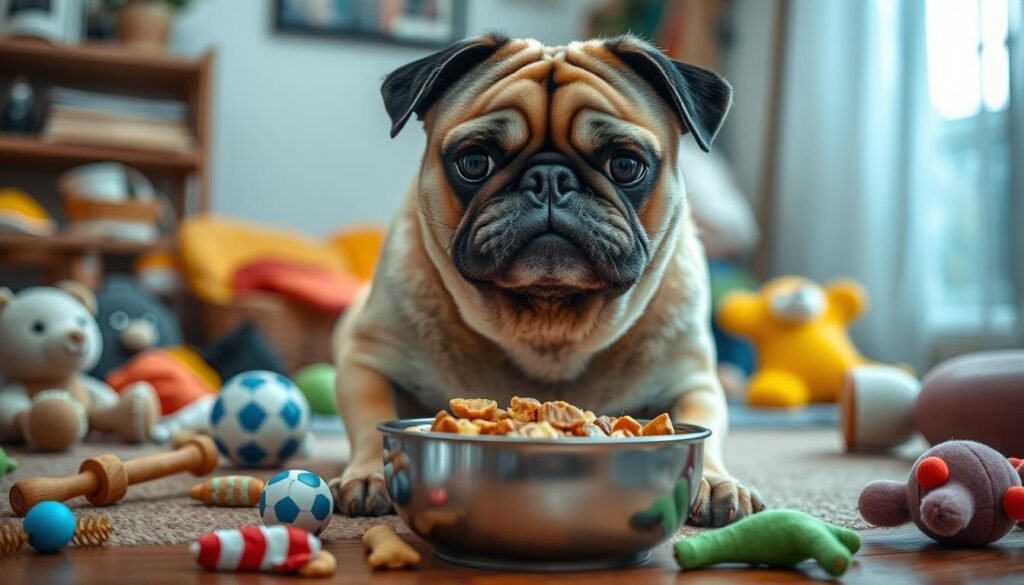
“Resource guarding behavior is a complex issue that requires a multifaceted approach to address effectively.”
How to Avoid Resource Guarding in Pugs
To stop resource guarding in Pugs, use several methods. These include desensitization, teaching “leave it” and “drop it,” and the “trade-up” method. These positive ways can help manage this issue in Pugs.
Desensitization and Counter-Conditioning Techniques
Desensitization means slowly getting your Pug used to things that make them guard, like being near while they eat. Pair these moments with good things, like treats or play. This helps your Pug see these situations as positive. Counter-conditioning makes this positive feeling stronger, reducing guarding.
Training the “Leave It” and “Drop It” Commands
Teaching “leave it” and “drop it” helps control guarding. “Leave it” means ignoring the item, and “drop it” means giving it up. With practice and rewards, your Pug will learn these important commands.
Using the “Trade-Up” Method
The “trade-up” method offers a better item for what they’re guarding. This shows them giving up is better. This method helps reduce guarding by offering a better reward.
Consistent training and positive reinforcement are crucial. If you need help, a professional dog trainer or behaviorist can offer personalized advice. They can help your Pug overcome guarding.
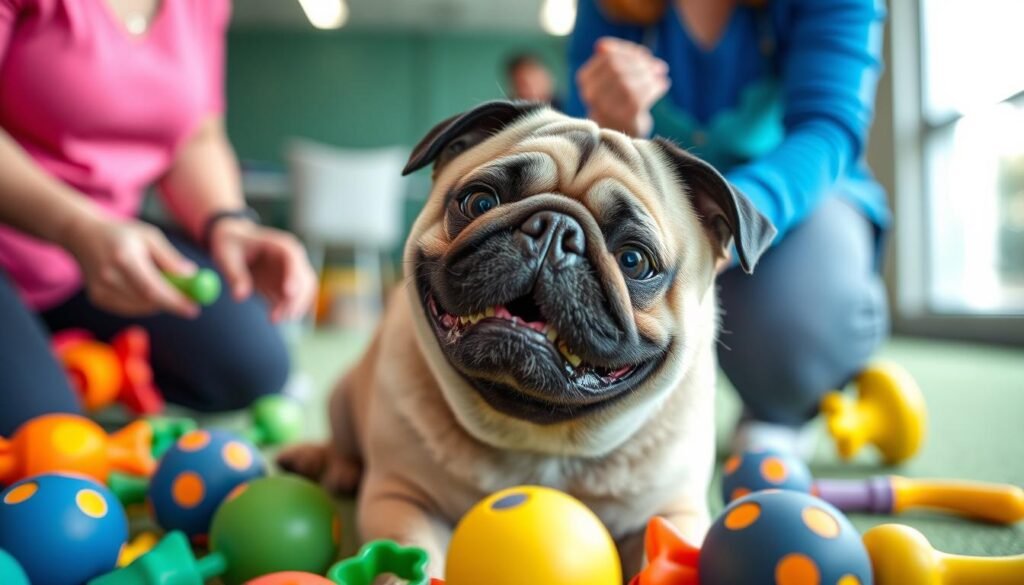
Managing Resource Guarding in Multi-Pet Households
Resource guarding is a common issue in dogs, especially in homes with multiple pets. It can be tough to handle when you have a Pug and another dog or a Pug and a cat. It’s crucial to tackle this problem to keep all pets safe and happy.
One effective strategy is to give each pet enough resources. This means having separate spots for eating, sleeping, and playing. By doing this, you can reduce fights over limited items.
Positive training, like teaching “leave it” and “drop it,” is also very helpful. These commands help pets learn to give up their favorite things. This can prevent big fights.
Also, watch closely in new situations and remove items that cause trouble. This might mean keeping some toys or treats away. Or, introduce new things slowly to avoid any guarding issues.
“Addressing resource guarding in multi-pet homes requires a multi-faceted approach, but with the right strategies, you can create a harmonious environment for all your furry friends.”
By using these methods, you can manage resource guarding in homes with many pets. This includes your Pug and other pets. Remember, stopping resource guarding is vital for the safety and happiness of all your pets.
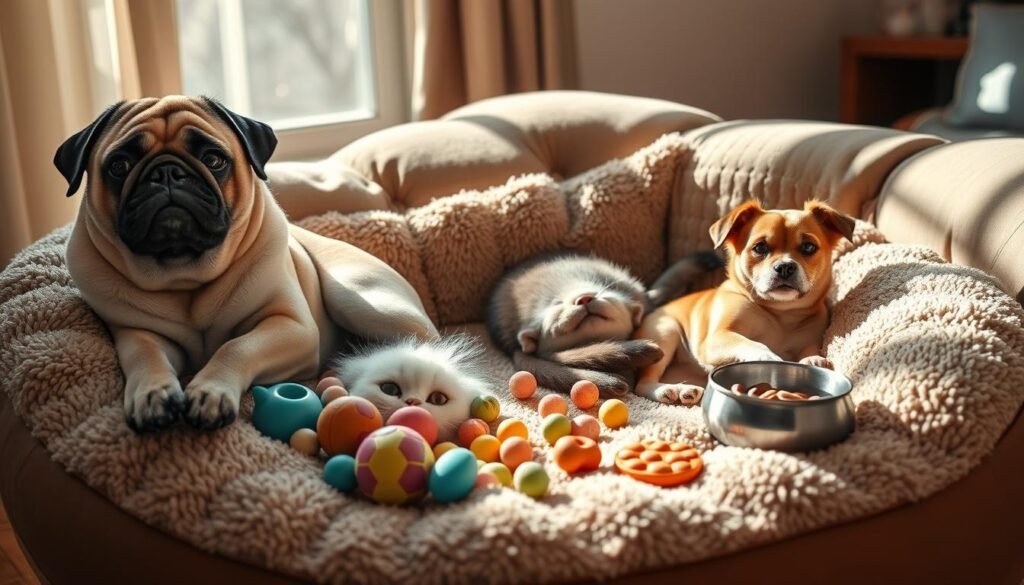
How to Avoid Resource Guarding in Pugs
Preventing resource guarding in Pugs is key for a safe and happy home. Understanding why they do this and using the right training can help. This way, you can keep your Pug and your home peaceful.
Desensitization and counter-conditioning are important strategies. Start by slowly introducing your Pug to things they value, like food or toys. Use positive rewards to make these experiences good ones. Also, teach them to “leave it” and “drop it” to avoid fights.
Keeping your Pug at a healthy weight is also vital. Too much weight can make them more likely to guard things. Give them good food and watch their portions. Slow feeder bowls can also help them eat slower and avoid overeating, which can lead to guarding.

